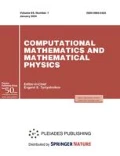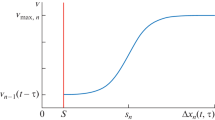Abstract
A statistical model of traffic flows designed for modeling the motion of vehicles on long highways is proposed. The model simulates the motion of groups of vehicles on the road using the fundamental flow–density diagram on a selected segment of the road with the purpose of calculating the speed of the group; it is assumed that the group size linearly depends on its speed. The proposed approach combines the advantages of macroscopic and microscopic simulation. That is, it allows one to simulate the motion of vehicles in megalopolises to a high accuracy and with low requirements for computational resources. The principles of simulation are described, algorithms for recalculating the model states are presented, and computational experiments confirming the validity and workability of the simulation results for various configurations of the road network are discussed. In the experiments, the fundamental flow diagram is constructed on the basis of sensors of the traffic control center.





Similar content being viewed by others
REFERENCES
V. M. Starozhilets and Yu. V. Chekhovich, “Integration of data from heterogeneous sources in the problem of modeling traffic flows,” Mash. Obuch. Anal. Dannykh 2 (3), 260–276 (2016).
M. J. Lighthill and G. B. Whitham, “On kinematic waves. II. A theory of traffic flow on long crowded roads.” Proc. Roy. Soc. A Mat. 229, 317–345 (1955).
P. I. Richards, “Shock waves on the highway,” Oper. Res. 4 (1), 42–51 (1956).
G. B. Whitham, Linear and Nonlinear Waves (Wiley, Hoboken, 1974).
C. F. Daganzo, “Requiem for second-order fluid approximations of traffic flow,” Transport. Res. B Meth. 29 (4), 277–286 (1995).
H. J. Payne, “Models of freeway traffic and control,” Math. Models Public Syst., No. 4, 51–61 (1998).
M. Papageorgiou, “Some remarks on macroscopic traffic flow modelling,” Transport. Res. A Pol. 32 (5), 323–329 (1998).
A. Aw and R. M. Michel, “Resurrection of "second order” models of traffic flow," SIAM J. Appl. Math. 60, 916–938 (2000).
M. Zhang, “A non-equilibrium traffic model devoid of gas-like behavior,” Transport. Res. B Meth. 36 (3), 275–290 (2002).
M. Zhang, “Anisotropic property revisited–does it hold in multi-lane traffic?” Transport. Res. B Meth. 37 (6), 561–577 (2003).
F. Siebel and W. Mauser, “On the fundamental diagram of traffic flow,” SIAM J. Appl. Math. 66, 1150–1162 (2006).
F. Siebel and W. Mauser, “Synchronized flow and wide moving jams from balanced vehicular traffic,” Phys. Rev. E. 73 (6), 066108 (2006).
P. P. Dey, S. Chandra, and S. Gangopadhyay, “Simulation of mixed traffic flow on two-lane roads,” J. Transport. Eng. 134 (9), 361–369 (2008).
Guo Hong-Wei, Gao Zi-You, Zhao Xiao-Mei, and Xie Dong-Fan, “Dynamics of motorized vehicle flow under mixed traffic circumstance,” Commun. Theor. Phys. 55, 719 (2011).
P. J. Gundaliya, V. M. Tom, and L. D. Sunder, “Heterogeneous traffic flow modeling for an arterial using grid based approach,” J. Adv. Transport. 42 (4), 467–491 (2008).
L. W. Lan, C.-W. Chang, and S. Gangopadhyay, “Inhomogeneous cellular automata modeling for mixed traffic with cars and motorcycles,” J. Adv. Transport. 39 (3), 323–349 (2005).
A. E. Alekseenko, Ya. A. Kholodov, A. S. Kholodov, A. I. Goreva, M. O. Vasil’ev, Yu. V. Chekhovich, V. D. Mishin, and V. M. Starozhilets, “Development, calibration, and verification of traffic model under urban conditions,” Part I, Kompyut. issledovaniya i modelirovaniya 7 (6), 1185–1203 (2015).
B. Kerner, The Physics of Traffic (Springer, Berlin, 2004).
A. V. Gasnikov, Introduction to the Mathematical Modeling of Traffic Flows (Litres, Moscow, 2015) [in Russian]
G. Long, “Acceleration characteristics of starting vehicles,” Transp. Res. Rec. 1737 (1), 58–70 (2000).
Funding
This work was supported by the Russian Foundation for Basic Research, project no. 17-07-01574.
Author information
Authors and Affiliations
Corresponding authors
Additional information
Translated by A. Klimontovich
Rights and permissions
About this article
Cite this article
Starozhilets, V.M., Chekhovich, Y.V. An Approach to Statistical Simulation of Traffic Flows. Comput. Math. and Math. Phys. 61, 1207–1218 (2021). https://doi.org/10.1134/S0965542521070150
Received:
Revised:
Accepted:
Published:
Issue Date:
DOI: https://doi.org/10.1134/S0965542521070150




